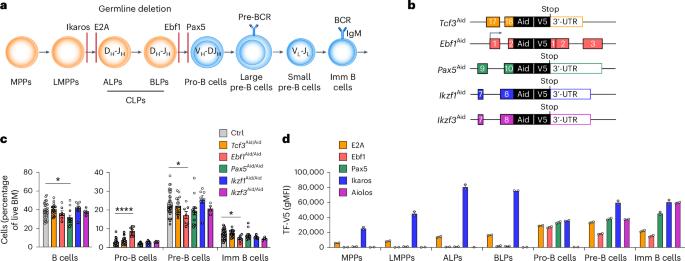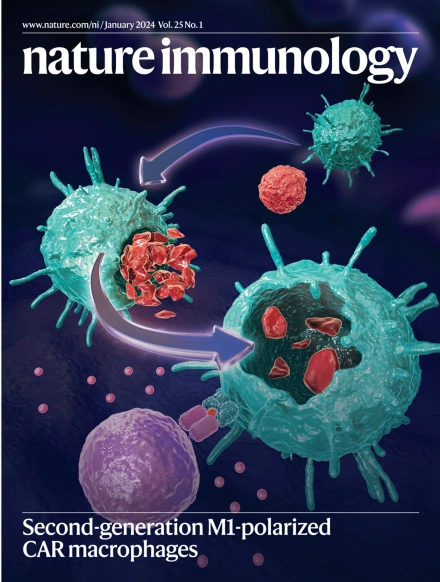通过体内急性蛋白降解分析早期 B 细胞发育过程中 E2A、Ebf1、Pax5、Ikaros 和 Aiolos 的转录功能
IF 27.7
1区 医学
Q1 IMMUNOLOGY
引用次数: 0
摘要
早期 B 细胞淋巴造血依赖于 E2A、Ebf1、Pax5 和 Ikaros 家族成员。在本研究中,我们利用小鼠急性蛋白降解来确定这些转录因子在前 B 细胞、小前 B 细胞和未成熟 B 细胞中的直接靶基因。E2A、Ebf1和Pax5主要通过诱导其靶基因的染色质开放而发挥转录激活剂的作用,它们在很大程度上具有独特的功能,并且对早期B细胞的维持至关重要。Ikaros 和 Aiolos 作为专门的抑制因子,协同控制早期 B 细胞的发育。在前 B 细胞中,代用轻链基因 Igll1 和 Vpreb1 被 Ebf1 和 Pax5 直接激活,而在小前 B 细胞中则被 Ikaros 和 Aiolos 直接抑制。Pax5 和 E2A 通过激活 Rag1、Rag2、Dntt、Irf4 和 Irf8 促进 V(D)J 重组。与 Pax5 类似,Ebf1 也能抑制粘合素释放因子基因 Wapl,从而介导 Igh 基因座上的长环挤出。总之,体内蛋白质降解为我们深入了解五种转录因子对早期B细胞淋巴细胞生成的控制提供了前所未有的视角。本文章由计算机程序翻译,如有差异,请以英文原文为准。


Transcriptional function of E2A, Ebf1, Pax5, Ikaros and Aiolos analyzed by in vivo acute protein degradation in early B cell development
Early B cell lymphopoiesis depends on E2A, Ebf1, Pax5 and Ikaros family members. In the present study, we used acute protein degradation in mice to identify direct target genes of these transcription factors in pro-B, small pre-B and immature B cells. E2A, Ebf1 and Pax5 predominantly function as transcriptional activators by inducing open chromatin at their target genes, have largely unique functions and are essential for early B cell maintenance. Ikaros and Aiolos act as dedicated repressors to cooperatively control early B cell development. The surrogate light-chain genes Igll1 and Vpreb1 are directly activated by Ebf1 and Pax5 in pro-B cells and directly repressed by Ikaros and Aiolos in small pre-B cells. Pax5 and E2A contribute to V(D)J recombination by activating Rag1, Rag2, Dntt, Irf4 and Irf8. Similar to Pax5, Ebf1 also represses the cohesin-release factor gene Wapl to mediate prolonged loop extrusion across the Igh locus. In summary, in vivo protein degradation has provided unprecedented insight into the control of early B cell lymphopoiesis by five transcription factors. By use of a degron-mediated acute protein degradation model, Schwickert and colleagues are able to distinguish between direct and indirect gene targets of multiple transcription factors involved in early B cell development.
求助全文
通过发布文献求助,成功后即可免费获取论文全文。
去求助
来源期刊

Nature Immunology
医学-免疫学
CiteScore
40.00
自引率
2.30%
发文量
248
审稿时长
4-8 weeks
期刊介绍:
Nature Immunology is a monthly journal that publishes the highest quality research in all areas of immunology. The editorial decisions are made by a team of full-time professional editors. The journal prioritizes work that provides translational and/or fundamental insight into the workings of the immune system. It covers a wide range of topics including innate immunity and inflammation, development, immune receptors, signaling and apoptosis, antigen presentation, gene regulation and recombination, cellular and systemic immunity, vaccines, immune tolerance, autoimmunity, tumor immunology, and microbial immunopathology. In addition to publishing significant original research, Nature Immunology also includes comments, News and Views, research highlights, matters arising from readers, and reviews of the literature. The journal serves as a major conduit of top-quality information for the immunology community.
 求助内容:
求助内容: 应助结果提醒方式:
应助结果提醒方式:


